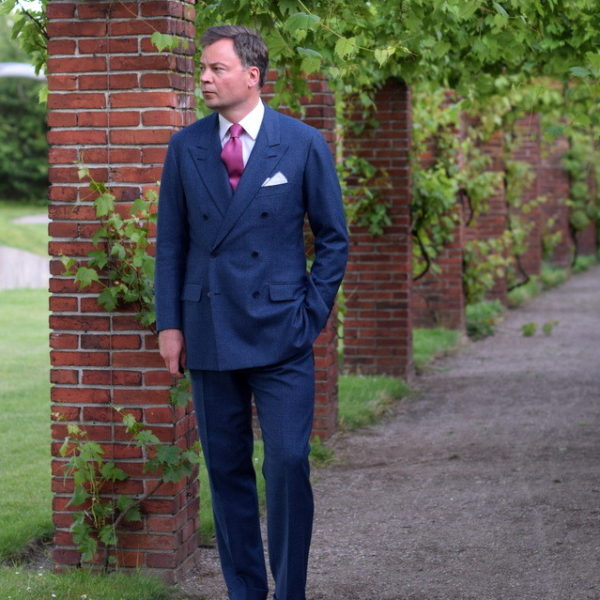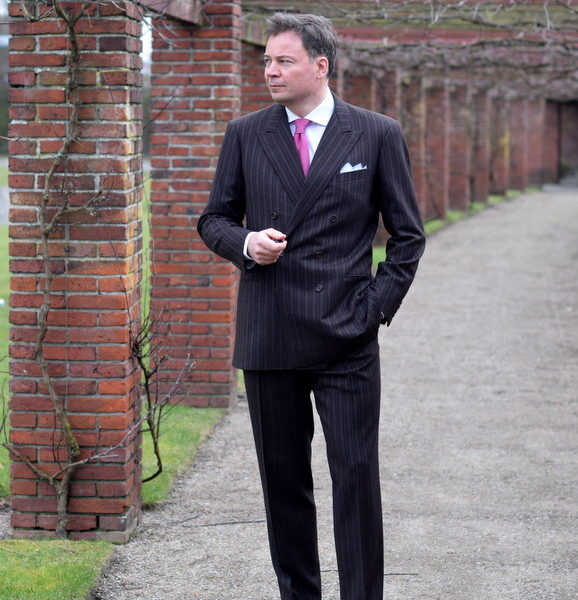
Torsten from Journal of Style recently commissioned three different suits from three different tailors. Their basic stylistic points are the same: double breasted jackets with peak lapels, welted pockets, and 6×2 closures. The only real difference is in the silhouettes – particularly in how the shoulders have been constructed.
His photos illustrate some important things for when you’re shopping for a suit or sport coat. A lot of men these days assume they should wear the softest shoulder possible (something about sprezzatura). The truth is, not everyone looks good in a soft shoulder and not all soft shoulders are built the same. Knowing how to spot the differences can help you pick what’s best for you. A run through of the three examples above:
- The Soft, Shirt-Like Shoulder: Sometimes referred to as spalla camicia (Italian for shirt shoulder), this construction is more and more popular in mid-range Italian ready-to-wear. There’s very little padding here and the sleeves have been inserted into the armholes like a tailor would do on a shirt – giving the jacket a more rounded and “natural” look. Notice in the first photo, Torsten’s mid-blue suit closely follows his own body and the shoulder line is a little more curved when compared to the other examples. The advantage here is well known: a soft shoulder like this will look more casual and relaxed, as well as feel like “second skin” when worn. The trade off, however, is that the jacket also looks less formal, which makes this not as ideal for serious business suits. On men with heavily sloped shoulders or rounded backs, it may also not look very flattering.
- The Slightly Padded Shoulder: A shoulder really has two parts. There’s the padding that goes across the shoulder and then the wadding – a tailoring term for a soft, fuzzy material that goes on top of the shoulder joints. The darker blue suit in the second photo has a bit more padding than the first example, but the biggest difference is in the wadding, which helps pick up the shoulder ends. That gives Torsten a straighter, broader-looking shoulder line. On some jackets, wadding can also be used to create an extended shoulder (which isn’t possible on a truly unstructured jacket). For men with narrow shoulders or less-than-athletic figures, this can give the illusion of a more V-shaped silhouette. After all, if you can’t nip the waist any more, an extended shoulder can make the waist look smaller by comparison.
- The Structured Shoulder: Finally, we have the structured shoulder, which is rarely seen on menswear blogs, but beautiful in its own right. Here, the shoulder line is a bit more padded than the previous two examples, as well as slightly extended. Notice how the shoulder construction alone gives the jacket a more angular silhouette – lending it a more authoritative air. This sort of construction can be good for men with heavily sloped shoulders, but the trade off is that the jacket will also look more formal. Good for business suits, but possibly harder to wear in sport coats if you live in an area with very casual dress norms.
Torsten is fortunate enough to look good in all three constructions, but not everyone is so blessed. When trying on a jacket, be honest with what you see in the mirror. The good thing about tailoring is that – unlike with casualwear – tailors can put a lot of structure beneath the surface to hide things we don’t like and reveal what we do. Take advantage of those options.
Incidentally, along with writing Journal of Style, Torsten also runs the online shop Grunwald. Both are very much worth following if you’re interested in classic men’s style and tailoring. The stuff in Torsten’s shop isn’t inexpensive, but the quality is exceptional and the value is high, especially given the strong exchange rate.
(photos via Journal of Style)


